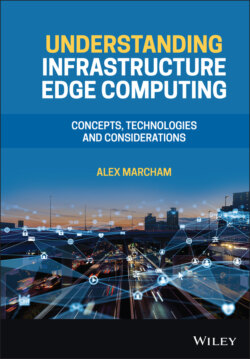Читать книгу Understanding Infrastructure Edge Computing - Alex Marcham - Страница 2
Table of Contents
Оглавление1 Cover
2 Title Page
3 Copyright Page
4 Dedication Page
5 Preface How to Use This Book About This Book Audience
6 About the Author
7 Acknowledgements
8 1 Introduction
9 2 What Is Edge Computing? 2.1 Overview 2.2 Defining the Terminology 2.3 Where Is the Edge? 2.4 A Brief History 2.5 Why Edge Computing? 2.6 Basic Edge Computing Operation 2.7 Summary References
10 3 Introduction to Network Technology 3.1 Overview 3.2 Structure of the Internet 3.3 The OSI Model 3.4 Ethernet 3.5 IPv4 and IPv6 3.6 Routing and Switching 3.7 LAN, MAN, and WAN 3.8 Interconnection and Exchange 3.9 Fronthaul, Backhaul, and Midhaul 3.10 Last Mile or Access Networks 3.11 Network Transport and Transit 3.12 Serve Transit Fail (STF) Metric 3.13 Summary References
11 4 Introduction to Data Centre Technology 4.1 Overview 4.2 Physical Size and Design 4.3 Cooling and Power Efficiency 4.4 Airflow Design 4.5 Power Distribution 4.6 Redundancy and Resiliency 4.7 Environmental Control 4.8 Data Centre Network Design 4.9 Information Technology (IT) Equipment Capacity 4.10 Data Centre Operation 4.11 Data Centre Deployment 4.12 Summary References
12 5 Infrastructure Edge Computing Networks 5.1 Overview 5.2 Network Connectivity and Coverage Area 5.3 Network Topology 5.4 Transmission Medium 5.5 Scaling and Tiered Network Architecture 5.6 Other Considerations 5.7 Summary
13 6 Infrastructure Edge Data Centres 6.1 Overview 6.2 Physical Size and Design 6.3 Heating and Cooling 6.4 Airflow Design 6.5 Power Distribution 6.6 Redundancy and Resiliency 6.7 Environmental Control 6.8 Data Centre Network Design 6.9 Information Technology (IT) Equipment Capacity 6.10 Data Centre Operation 6.11 Brownfield and Greenfield Sites 6.12 Summary
14 7 Interconnection and Edge Exchange 7.1 Overview 7.2 Access or Last Mile Network Interconnection 7.3 Backhaul and Midhaul Network Interconnection 7.4 Internet Exchange 7.5 Edge Exchange 7.6 Interconnection Network Technology 7.7 Peering 7.8 Cloud On‐ramps 7.9 Beneficial Impact 7.10 Alternatives to Interconnection 7.11 Business Arrangements 7.12 Summary
15 8 Infrastructure Edge Computing Deployment 8.1 Overview 8.2 Physical Facilities 8.3 Site Locations 8.4 Coverage Areas 8.5 Points of Interest 8.6 Codes and Regulations 8.7 Summary
16 9 Computing Systems at the Infrastructure Edge 9.1 Overview 9.2 What Is Suitable? 9.3 Equipment Hardening 9.4 Rack Densification 9.5 Parallel Accelerators 9.6 Ideal Infrastructure 9.7 Adapting Legacy Infrastructure 9.8 Summary References
17 10 Multi‐tier Device, Data Centre, and Network Resources 10.1 Overview 10.2 Multi‐tier Resources 10.3 Multi‐tier Applications 10.4 Core to Edge Applications 10.5 Edge to Core Applications 10.6 Infrastructure Edge and Device Edge Interoperation 10.7 Summary
18 11 Distributed Application Workload Operation 11.1 Overview 11.2 Microservices 11.3 Redundancy and Resiliency 11.4 Multi‐site Operation 11.5 Workload Orchestration 11.6 Infrastructure Visibility 11.7 Summary
19 12 Infrastructure and Application Security 12.1 Overview 12.2 Threat Modelling 12.3 Physical Security 12.4 Logical Security 12.5 Common Security Issues 12.6 Application Security 12.7 Security Policy 12.8 Summary
20 13 Related Technologies 13.1 Overview 13.2 Multi‐access Edge Computing (MEC) 13.3 Internet of Things (IoT) and Industrial Internet of Things (IIoT) 13.4 Fog and Mist Computing 13.5 Summary Reference
21 14 Use Case Example 14.1 Overview 14.2 What Is 5G? 14.3 5G at the Infrastructure Edge 14.4 Summary
22 15 Use Case Example 15.1 Overview 15.2 What Is AI? 15.3 AI at the Infrastructure Edge 15.4 Summary
23 16 Use Case Example 16.1 Overview 16.2 What Are Cyber‐physical Systems? 16.3 Cyber‐physical Systems at the Infrastructure Edge 16.4 Summary Reference
24 17 Use Case Example 17.1 Overview 17.2 What Is Cloud Computing? 17.3 Cloud Computing at the Infrastructure Edge 17.4 Summary
25 18 Other Infrastructure Edge Computing Use Cases 18.1 Overview 18.2 Near Premises Services 18.3 Video Surveillance 18.4 SD‐WAN 18.5 Security Services 18.6 Video Conferencing 18.7 Content Delivery 18.8 Other Use Cases 18.9 Summary
26 19 End to End 19.1 Overview 19.2 Defining Requirements 19.3 Success Criteria 19.4 Comparing Costs 19.5 Alternative Options 19.6 Initial Deployment 19.7 Ongoing Operation 19.8 Project Conclusion 19.9 Summary
27 20 The Future of Infrastructure Edge Computing 20.1 Overview 20.2 Today and Tomorrow 20.3 The Next Five Years 20.4 The Next 10 Years 20.5 Summary
28 21 Conclusion
29 Appendix A: Acronyms and Abbreviations
30 Index
31 End User License Agreement
